
| Version | Summary | Created by | Modification | Content Size | Created at | Operation |
|---|---|---|---|---|---|---|
| 1 | Jason Zhu | -- | 3402 | 2022-11-01 01:41:16 |
Video Upload Options
A photonic laser thruster (PLT) is an amplified photonic propulsion thruster for space propulsion that works on the principle of a photon-pushed sail, generating thrust directly from the momentum of a photon from a laser reflected from a mirror. The thruster, invented by Young K. Bae differs from other solar sail and laser propulsion thrusters in that an amplification process is used, in which the incident beam is re-used by being reflected by a stationary mirror, with an amplification stage at each reflection. Because of the recycling of energy, the photonic laser thruster has been demonstrated to be more energy efficient than other laser-pushed sail concepts. The near-term usage of the photonic laser thruster the earth-orbit applications include propellant-free and thrust-plume-contamination-free spacecraft maneuvering for precision formation flying, large optical and RF synthetic aperture construction, and stationkeeping. The usage of the photonic laser thruster for main space propulsion would require scaling-up of the laser power and controlling laser diffraction over interplanetary and interstellar distances. Photonic laser thrusters have a very high specific impulse, and can permit spacecraft to reach much higher speeds that approach a fraction of the light speed, unlike conventional rockets, which are limited by the Tsiolkovsky rocket equation.
1. History
1.1. Background
The use of light for propulsion has been researched since the beginning of the 20th century,[1] with the analysis of a sail pushed by the pressure of sunlight by Friedrich Tsander.[2] Photon propulsion has been discussed for decades as a propulsion that could enable interstellar flight.[3][4]
In the traditional photonic propulsion, such as laser- or microwave-pushed lightsails, photons transfer their momentum to the sail by reflection. Since, for a sail moving slowly with respect to the speed of light, very little of the energy of the photon is lost on reflection, a theoretical way to increase the efficiency is by recycling photons, bouncing the reflected photons back to the sail by a mirror,[5] resulting in repetitively cycling the photons between two reflective mirrors in an optical cavity.
The photonic thruster utilized this approach of recycling the reflected light, but with the addition of an active material amplifying the beam.
1.2. Development
The Photonic Laser Thruster (PLT) was invented and developed by Young Bae and his team at Y.K. Bae Corp for use in nanometer precision spacecraft formation under a NASA Institute for Advanced Concepts (NIAC) grant in 2006,[6] for forming space telescopes and radars. Initial proposed uses include high-precision and high-speed maneuver of small spacecraft, such as formation flying, orbit adjustments, and drag compensation. In this research Bae discovered that photonic laser thruster was stable against movements of laser mirrors and proved that it can be used for main propulsion.[7][8][9] In this program he demonstrated a 100-fold improvement in conversion efficiency, reaching a photon thrust of 35 micronewtons by putting the laser-energizing medium between two mirrors as in typical lasers.
In August 2015, under another NASA program (NIAC, NASA Innovative Advanced Concepts) he demonstrated additional 100-fold improvement, achieving a photon thrust of 3.5 millinewtons. In addition, a small 1U CubeSat satellite was propelled and stopped in simulated zero-gravity. The laser power of the trapped photon beam exceeded 500 kW, which was powered by a 500 W laser. The concept is proposed for beaming thrust from a conventional heavy "tanker" vehicle to a more expensive, lightweight mission vehicle, similar to aerial refueling.[10][11]
2. Approaches
2.1. Beamed Laser Propulsion
The limitations posed by the rocket equation can be overcome, as long as the reaction mass is not carried by the spacecraft. In the Beamed Laser Propulsion (BLP) concept, the photons are beamed from the photon source to the spacecraft as coherent light. Robert L. Forward pioneered interstellar propulsion concepts including photon propulsion and antimatter rocket propulsion.[3][12] Specifically, Forward introduced beamed laser propulsion, aiming at the goal of achieving roundtrip manned interstellar travel.
2.2. Recycling Photon Propulsion
Marx,[13] Redding[14] and Simmons and McInnes[15] calculated that the energy conversion efficiency of terrestrial laser-driven propulsion is approximately proportional to v/c at low speeds (v<0.1c), thus is small at low speeds (v<<0.1c). However, at higher speeds (v>0.1c), owing to the favorable Doppler shift energy transfer, onboard photon propulsion becomes much more energy efficient.
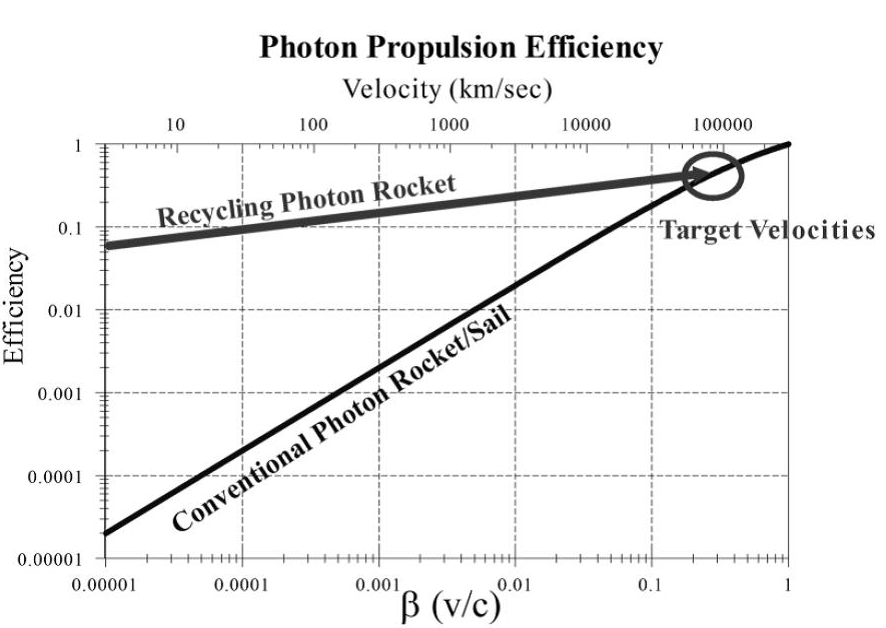
Photons transfer their energy to the spacecraft by redshifting due to Doppler shift upon reflection, thus the higher the spacecraft speed, the higher the efficiency. The figure shows the energy transfer efficiency from photons to the spacecraft's kinetic energy as a function of β=v/c (the spacecraft velocity divided by the light velocity) in photon propulsion. As the spacecraft velocity approaches the light velocity (v≈c), the efficiency of photon propulsion approaches 100%, as if the spacecraft acts like a black hole in the moving direction.[16] The lower solid curve in the figure represents the efficiency of conventional photon rocket or sail with photon recycling. The upper solid line represents schematically an example the efficiency of a recycling photon rocket, such as a PLT. At low β, the recycling rocket can have a high thrust amplification factor (in this example, ~3,000), however as β approaches 1, the amplification factor converges to 1 and the overhead of recycling is unneeded. Therefore, these rockets are projected to bridge the efficiency gap.
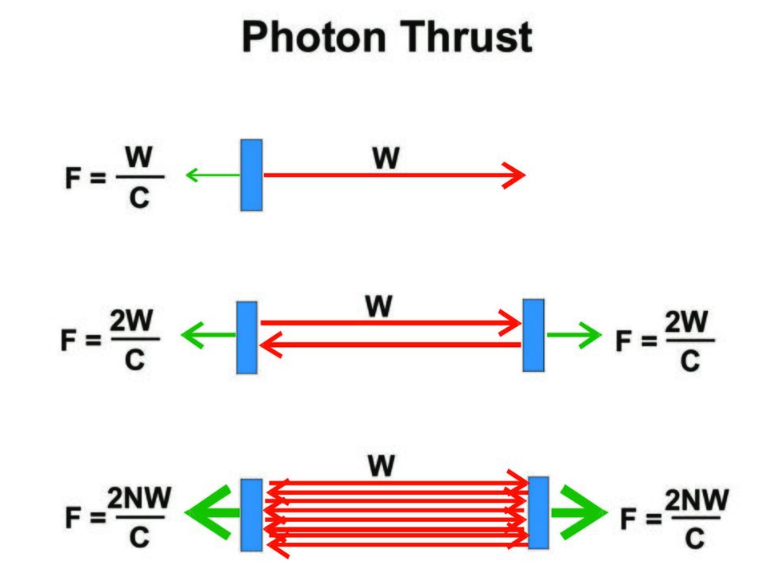
The simplest recycling scheme is a Herriot cell with multi-bouncing laser beams between two high reflectance mirrors that do not form a resonant optical cavity as illustrated in Figure 4. This cell type approach was first proposed by Meyer, et al.,[17] followed by Simmons and McInnes.[15] Mertzger and Landis[5] proposed a multi-bounce lightsail craft, such that the beam is reflected back and forth between the lightsail and a source reflector. Advanced reflectors permit more than 1000 bounces, reducing power requirements by 1000x compared to single bounce proposals. Using 100 MW to 1 GW lasers, a sub-100 day Mars transit is possible.[5] The first experimental attempt on photon thrust amplification in a non-resonant Herriot-cell type optical cavity was performed by Gray et al.[18] who obtained amplified photon thrust of ~0.4 µN with a 300-W laser and a photon thrust amplification factor of ~2.6.[9]
The passive resonator in the Fabry-Perot interferometer has been extensively used in high-sensitivity optical detection methods, such as the cavity ring-down spectroscopy. One experiment produced 20,000 photon bounces using mirrors with 0.99995 reflectance.[19][20] in which even one nanometer perturbation in cavity length destroys the resonance and nulls the photon thrust. The injection of laser power into the cavity remains challenging.
Meyer et al.[17] concluded that for interstellar flights, recycling photon propulsion vehicles are much more energy efficient than an onboard photon rocket, such as the nuclear photonic rocket. They proposed possible applications of photon recycling using passive resonant optical cavities (lasers outside the optical cavity), such as the Laser Elevator.[17]
Photonic laser thruster
After 2000 Bae began to investigate photon recycling for use in a nanometer accuracy formation flight, for a NASA-NIAC project called Photon Tether Formation Flight (PTFF).[6] The goal was to sustain fixed-formation flight with a baseline distance between craft of over 10 km, for next generation NASA space missions. In 2006 Bae investigated active resonant optical cavities, in which the optical gain medium is located within the cavity, and coined the term "photonic laser thruster" (PLT) for such thrusters.[7][8][9][21]
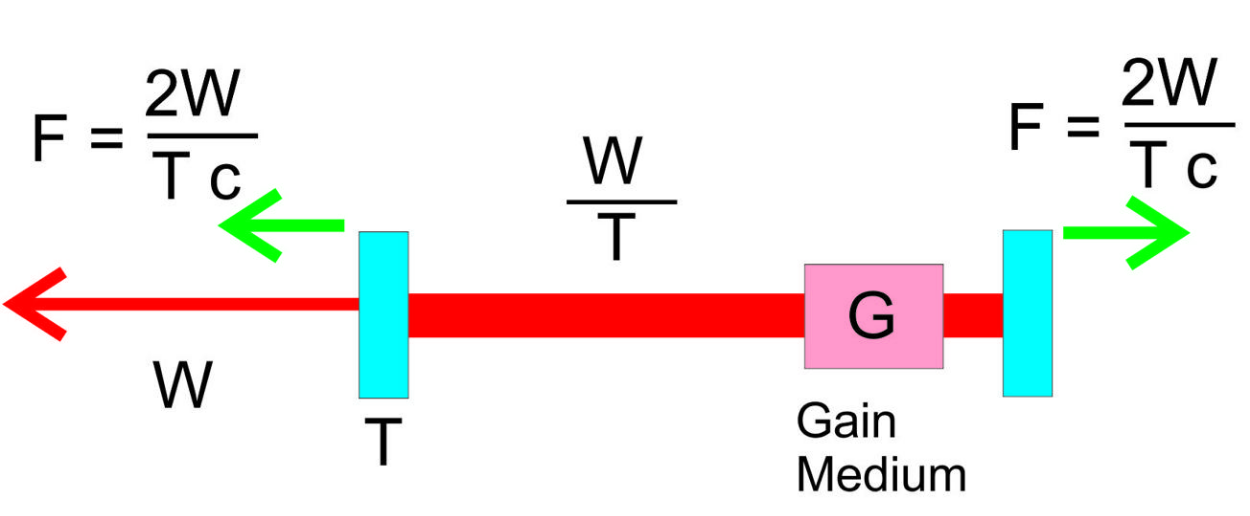
Initially PLT was proposed.[6] It was assumed that the cavity would be sensitive to the stability of the mirrors and other optical parameters as in passive cavities. Bae discovered that he could sustain the resonance with the mirror in his hand.[7][8] This would be impossible if the cavity were highly sensitive to cavity perturbations such as moving and tilting. He concluded the gain medium in the cavity actively stabilizes the recycling photon beam, through negative feedback. This encouraged the idea that these thrusters could enable a range of applications well beyond PTFF.[6][8]thumb|Figure 6: Schematic diagram of the first Photonic Laser Thruster (PLT) demonstration setup in December 2006.|298x298px In December 2006, a proof-of-concept of PTFF was demonstrated in a laboratory environment.[6][7][8] Figure 6 illustrates the first demonstration setup, consisting of a concave High Reflectance (HR) mirror, a Nd:YAG Diode Pumped Solid State laser gain medium and a flat Output Coupler (OC) mirror. The photon thrust was determined by measuring the difference between the weight of the HR mirror with laser on and that with laser off with the use of a digital scale. Below is an infrared picture of the thruster in action.
Figure 7 shows the experimental results of the photon thrust measured as a function of the laser power output through the OC mirror, P, with reflectance greater than 0.997 according to the manufacturer’s specification. Curve fitting the data resulted in the specific thrust of 20±1 µN/W, resulting in the apparent photon momentum multiplication factor of 2,990±150 and the true OC mirror reflectance used in this demonstration of 0.99967±0.00002. The maximum photon thrust demonstrated was 35 μN. When the demonstration setup was operating at thruster levels near or beyond 35 µN, the setup became unstable and the gain medium overheated. Therefore, it was realized that thermal management is critical to scaling such thrusters.[7][8]
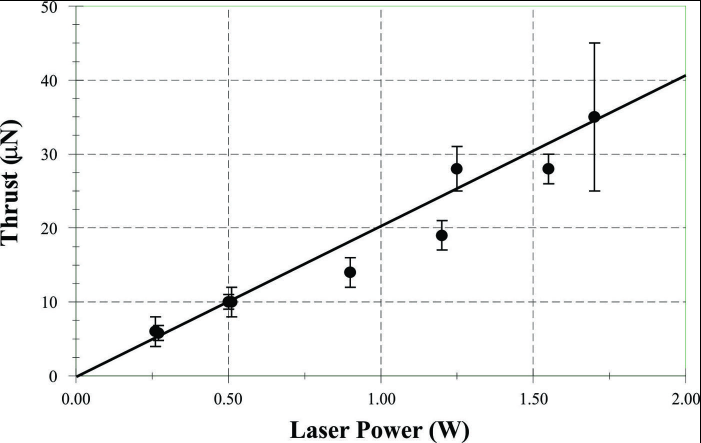
The Doppler shift limits the maximum obtainable velocity of the accelerating mirror and its accommodating spacecraft. Doppler shift effect on the active resonant cavity behavior is an extremely complicated issue.[7][8] Optical gain in the laser cavity can only occur for a finite range of optical frequencies. The gain bandwidth is approximately the width of this frequency range. For example, the gain bandwidth of the YAG laser system with the laser wavelength in the order of 1,000 nm is in the order of 0.6 nm,[22] ~ 0.06% of the wavelength. For an order of magnitude estimation, it can be assumed that a thruster utilizing the YAG laser system will be limited by the gain bandwidth to the first order, i.e., its theoretical maximum spacecraft velocity is ~1.8×105 m/s (180 km/s), 0.06% of the light velocity, c=3x108 m/s. To overcome this redshift limitation, at high operation velocities, wide bandwidth lasers should be used.[16]
Greater thrust requires higher power lasers.[23] Lasers are often designed to maximize power outside the laser cavity, while PLT calls for maximizing laser power inside the cavity.[7][8] The necessary laser operation parameters to maximize intracavity power (circulating power) in laser cavities are still poorly understood.
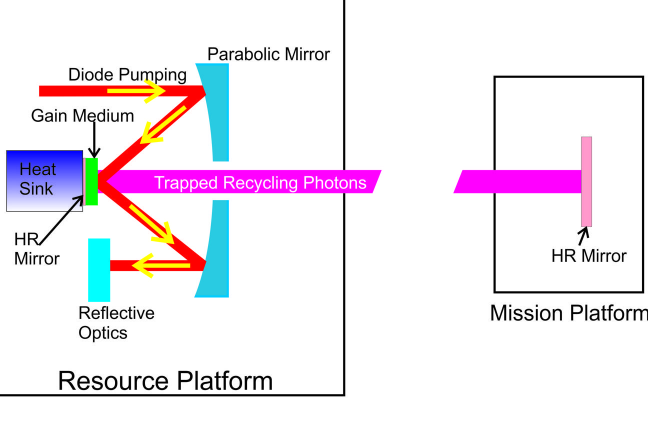
Bae and colleagues chose a thin disk laser and began to develop a PLT in 2013.[23] Typically, a thin disk laser with a 0.2 mm disk thickness can be operated with a 99% output coupler, and provide an intracavity power 100 times larger than extracavity power.[24] A schematic diagram of this design is shown in Figure 8. A thin disk gain medium is coated with HR with a reflectivity of up to 99.999% and attached to a heat sink. The recycling photons between the gain medium and the HR mirror located in the mission platform deliver amplified thrust beaming from the resource platform.
In 2014, Bae's group, working under a NASA program (NIAC, NASA Innovative Advanced Concepts), demonstrated intracavity power of 154 kW with a 0.6 cm diameter thin disk laser, which can be translated into a photon thrust of 1.03 mN.[25] In April 2015, the group successfully measured photon thrust up to 1.1 mN with a digital scale. They were able to accelerate, slow and stop a 0.45 kg spacecraft-simulating platform along a 2m frictionless air track in a Class-1,000 cleanroom.[26] In August 2015, under the NASA program the group successfully demonstrated and measured photon thrust up to 3.5 mN with the use of the newly developed NIST/Scientech/Navy radiation pressure sensor. An intracavity power of the photonic laser thruster over 500 kW was demonstrated with 500 W laser pumping.
Open problems
To date the experimental tests of the photonic thruster are limited to laboratory-scale distances. The maximum range of operation for a photonic laser thruster, PLT, is yet to be established. Bohn[27] demonstrated a 1 km-long laser resonator similar to the PLT cavity, which is an active cavity, in 1995 and proposed that such resonators could scale to 100 km. Recently, 4-km Fabry–Pérot cavities, which are passive cavities, but share the same intracavity power multiplication principle with the PLT cavity, have been demonstrated in LIGO for gravitational wave detection with an intracavity multiplication factor of 280 and an intracavity laser power on the order of 100 kW. Based on these results and the state-of-the-art technologies in precision optics, the PLT cavity length over 1,000 km is promising. Further studies need to be performed to determine whether the PLT cavity could be scaled for astronomical distances.[16]
Likewise, use of the amplifying cavity has not yet been demonstrated for the case when the sail is moving at velocities approaching fractions of the light velocity. The Doppler shift of the moving sail will, as noted earlier, mean that the amplification medium will need to operate at a different wavelength for each pass of the photons through the system. The mode of the Fabry-Perot cavity will likewise be changing with time.
Another issue is intracavity laser beam aiming, aligning and tracking over long distances.[16] Progress in directed energy weapons has improved these capabilities. The speed of light limits how quickly tracking information can travel between the two cavity ends over long distances.
At speeds higher than rocket speeds lack of brakes is a problem.[28] Such a problem can be solved by installing another photonic laser thruster at the destination as in photonic railway.[16] The braking of spacecraft with PLT in lab has been recently demonstrated.[29]
3. Applications
3.1. Orbit Tuning
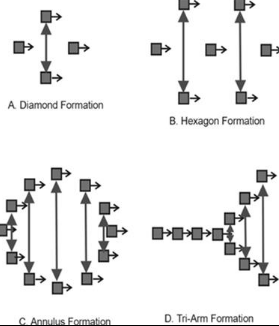
PLTs are studied for maneuvering spacecraft in near earth orbit, propellantless operation, thrust and power beaming for "perpetual" stationkeeping, and ultra-precision spacecraft formation flying, with or without tethers.[6][10]
Norman and Peck analyzed[10][11] a group of spacecraft that can exploit relative positions and velocities so that differential gravity provides a force opposite to the photon thrust from a PLT. In such a scheme, with two orbiting platforms moving in formation, when the photon thrust changes, their positions relative to the center of mass change as well, until the "virtual gravitational tug" counterbalances it again.[11][21] Existing concepts with conventional thrusters are not persistent, are mechanically constrained (e.g. with tethers), or lie within the orbital plane, limiting their aperture for earth-observation missions.[11] This system in contrast could control of out-of-plane motions. Figure 9 shows examples of "virtual tug" satellite formations for forming large synthetic apertures in Low Earth Orbit.
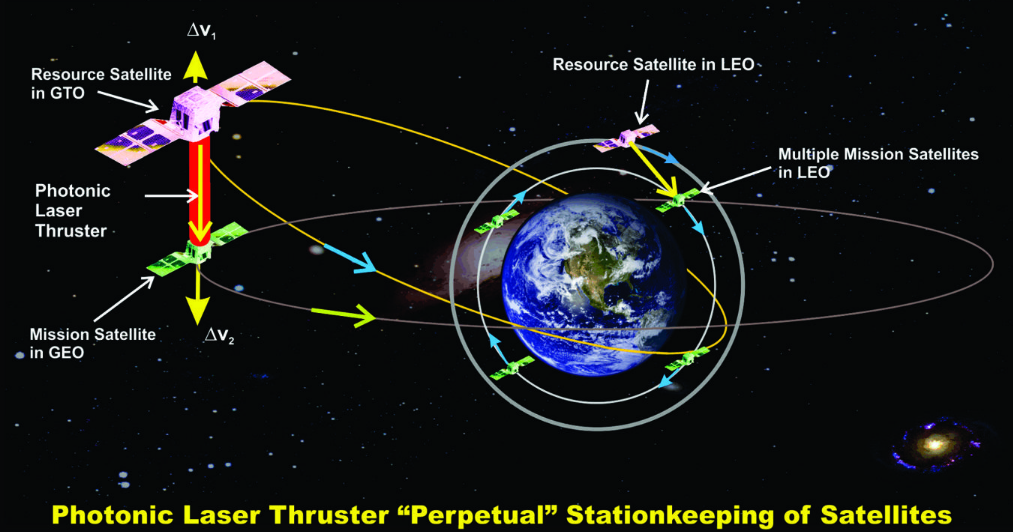
Similarly, small orbital craft that need to correct for orbital drag could do this with significantly less propellant, by moving a larger resource vehicle into a similar orbit with low inter-vehicle velocity. The replacement of such a resource vehicle could be faster and more economical.
3.2. Space Trave
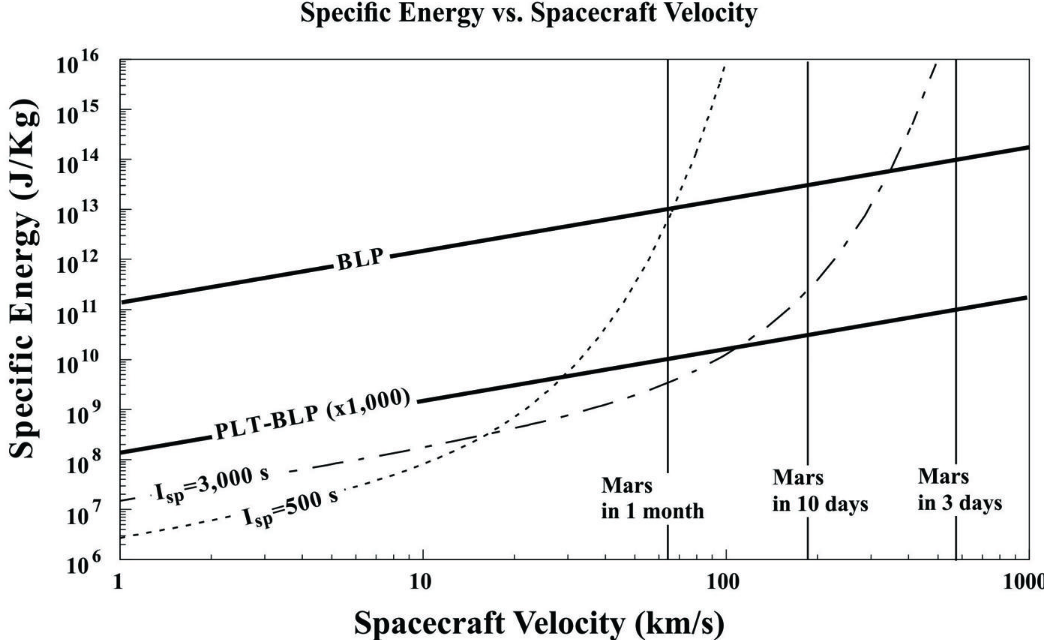
Bae proposed a 4-staged developmental map towards interstellar flight.[16] This would involve the photonic railway, a permanent energy-efficient transportation infrastructure based on Photonic Laser Thruster (PLT) in combination with Forward's model of beamed-laser propulsion (BLP),[3][12] a PLT-BLP hybrid.[7][8][9][21] This would reduce the cost and duration of interstellar commutes via proposed spacetrains.[16] The Stage-1 focuses on the near-earth space endeavors, such as orbit tuning, with Photonic Laser Thruster. The Stage-2 focuses on Interlunar photonic railway between the earth and the moon. The Stage-3 focuses on Interplanetary photonic railway between the earth and planets, moons and asteroids in the solar system. The Stage-4 focuses on Interstellar photonic railway between the planets and moons of the solar system and those of other star systems.
Photonic railway
If the photonic laser thruster is scalable for the use in such main space propulsion, multiple photonic laser thrusters can be used to construct a photonic railway that has been proposed as a potential permanent transport infrastructure for interplanetary or interstellar commutes, allowing the transport craft themselves to carry very little or no fuel.[16] The photonic railway[16] was investigated for a space applications involving planets, moons and asteroids both in the solar system and other star systems, such as mining and setting up permanent habitation, with regular interplanetary and interstellar travel.[3][12]
For example, platforms could be built in Earth orbit and then used for constructing further platforms at one of the Lagrange points of a planet of interest.[16] For Mars, solar power is still strong, thus solar pumped platforms could be operated near Mars. Planets farther from the sun might not support solar pumping, and the railway would involve two PLT-BLP systems near Earth.
Bae compared the energy need to speed spacecraft for conventional rockets and that for photonic railway or PLT-BLP, in terms of specific energy (J/kg) that is the energy required for propelling a unit mass to a given velocity.[16][17] Fig. 11 shows examples of the specific energy (J/kg) as a function of the spacecraft velocity (km/s) related with the Mars photonic railway. Two curves represent the specific energies for conventional rockets with Isp = 500 s and 3,000 s, respectively. The upper straight solid line represents the specific energy for BLP and the lower straight solid line for photonic railway or PLT-BLP with M=1,000. Here M is the photon thrust amplification factor. It is interesting that BPL becomes more energy efficient than rockets with Isp=500 s, if the travel time needs to be shorter than 1 month. BPL becomes more energy efficient than rockets with Isp=3,000 s, if the travel time is shorter than a week. However, photonic railway or PLT-BPL with M=1,000 becomes more energy efficient than rockets with Isp=500 s, if the travel time needs to be shorter than 2 month. BPL becomes more energy efficient than rockets with Isp=3,000 s, if the travel time needs to be shorter than two weeks. Eventually, when the flight time needs to be 3 days, for example, both BLP and photonic railway or PLT-BLP are more energy efficient than rockets with Isp=3,000 s. This estimate demonstrates photonic railway is potentially the most energy efficient way to commute to planets in the solar system.
One interesting aspect of the Spacetrain on the photonic railway was realized that the continuous low level acceleration of up to 1 g will create an artificial gravity that may eliminate or minimize the health effects of weightlessness long term space travel in zero-gravity environment.[16] This artificial gravity will play a crucial role in reducing or eliminating the health problems arising from the typical zero-g space travel environment.
A simple PLT system could provide continuous and constant thrust in a straight line. However, travel around the solar system involves interacting with planets and the sun, so trajectories and travel time calculations are more complex. Fu-Yuen Hsiao has investigated the trajectories of spacecraft relying entirely on a PLT.[30]
Bae's investigation concluded that the development of interplanetary and interstellar photonic railway will require development of the ways to utilize Photon Bose Einstein Condensation or diffraction-minimized laser beam propagation with non-diffracting beams, such as Bessel beam, or x-ray lasers and future advanced material science and technologies. Bae further concluded that the realization of the interstellar photonic railway would require that the PLT technology developments ride on the Moore’s law as the 20th century silicon devices did.
References
- Tsander, Friedrich (1967). "From a Scientific Heritage". NASA TTF-541.
- Tsander, Friedrich (1925). "Problems of flight by jet propulsion: interplanetary flights"; in English translation as NASA Technical Translation F-147 (1964)
- Humble, R.W.; Henry, G.N.; Larson (1 September 1995). Space Propulsion Analysis and Design. New York: McGraw-Hill Co.. pp. 631–683. ISBN 978-0-07-031320-0. https://books.google.com/books?id=GLWHQgAACAAJ.
- G. A. Landis, “The Ultimate Exploration: Approaches to Interstellar Flight,” Interstellar Exploration, Y. Kondo, ed., Apogee Books (2003).
- Mertzger, R.A.; Landis, G. (2001). "Multi-Bounce Laser-Based Sails". AIP Conference Proceedings 555: 397. doi:10.1063/1.1357953. http://connection.ebscohost.com/c/articles/5662879/multi-bounce-laser-based-sails.
- Bae, Young K. (2006-01-20). "A Contamination‐Free Ultrahigh Precision Formation Flying Method for Micro‐, Nano‐, and Pico‐Satellites with Nanometer Accuracy". AIP Conference Proceedings (AIP Publishing) 813: 1213–1223. doi:10.1063/1.2169304. http://scitation.aip.org/content/aip/proceeding/aipcp/10.1063/1.2169304.
- Bae, Young (2007), "Photonic Laser Thruster (PLT): Experimental Prototype Development and Demonstration", AIAA Space 2007 Conference & Exposition, Long Beach, CA (American Institute of Aeronautics and Astronautics): paper 2007-6156-318, doi:10.2514/6.2007-6156, http://arc.aiaa.org/doi/abs/10.2514/6.2007-6156 ; Sept. 18-20, 2007.
- Bae, Y.K. (2008). "Photonic Laser Propulsion: Proof-of-Concept Demonstration". AIAA Journal of Spacecraft and Rockets 45: 153–155. doi:10.2514/1.32284. Bibcode: 2008JSpRo..45..153B. https://dx.doi.org/10.2514%2F1.32284
- Bae, Young (2007), "Photonic Laser Propulsion (PLP): Photon Propulsion Using an Active Resonant Optical Cavity", AIAA Space 2007 Conference & Exposition, Long Beach, CA (American Institute of Aeronautics and Astronautics), doi:10.2514/6.2007-6131, http://arc.aiaa.org/doi/abs/10.2514/6.2007-6131 Sept. 18-20, 2007.
- Bae, Y.K. (2012). "DE Momentum Beaming (DEMB) for Innovative Spacecraft Maneuvering". DEPS Conference Proceedings. http://ykbcorp.com/downloads/DEMB.pdf.
- Norman, Michael; Peck, Mason. Orbit Maneuvers Through Inter-Satellite Forcing. American Institute of Aeronautics and Astronautics. doi:10.2514/6.2009-6097. http://arc.aiaa.org/doi/abs/10.2514/6.2009-6097.
- Forward, R.L. (1987). "Advanced Space Propulsion Study". AFRL Final Report: F04611-86-C-0039. http://www.dtic.mil/dtic/tr/fulltext/u2/a189218.pdf.
- Marx, G. (1966). "Interstellar vehicle propelled by terrestrial laser beam". Nature 211: 22–23. doi:10.1038/211022a0. Bibcode: 1966Natur.211...22M. https://dx.doi.org/10.1038%2F211022a0
- Redding, J.L. (1967). "Interstellar vehicle propelled by terrestrial laser beam". Nature 213: 588–589. doi:10.1038/213588a0. Bibcode: 1967Natur.213..588R. https://dx.doi.org/10.1038%2F213588a0
- Simmons, J.F.L.; McInnes, C.R. (1993). "Was Marx right? Or how efficient are laser driven interstellar spacecraft?". American Journal of Physics 61: 205. doi:10.1119/1.17291. Bibcode: 1993AmJPh..61..205S. https://dx.doi.org/10.1119%2F1.17291
- Bae, Y.K. (2012). "Prospective of photon propulsion for interstellar flight". Physics Procedia 38: 253–279. doi:10.1016/j.phpro.2012.08.026. Bibcode: 2012PhPro..38..253B. http://www.sciencedirect.com/science/article/pii/S187538921202514X.
- Meyer, T.R. (1985). "Rapid Delivery of Small Payloads to Mars". American Astronautical Society Science and Technology Series 62: 419. http://biblioteca.universia.net/html_bura/ficha/params/title/rapid-delivery-of-small-payloads-to-mars/id/43072158.html.
- Gray, P.A. (2002). "Photon Flux Amplification for Enhancing Photonic Laser Propulsive Fo". AIAA 33 rd. Plasmadynamics and Lasers Conference Proceedings. https://ntrs.nasa.gov/search.jsp?R=20030005445.
- Romanini, D. (1997). "CW Cavity Ring Down Spectroscopy". Chem. Phys. Lett. 264: 316–322. doi:10.1016/s0009-2614(96)01351-6. Bibcode: 1997CPL...264..316R. https://dx.doi.org/10.1016%2Fs0009-2614%2896%2901351-6
- Sheard, B.S. (2004). "Observation and Characterization of an Optical Spring". Phys. Rev. A 69: 051801(R). doi:10.1103/physreva.69.051801. Bibcode: 2004PhRvA..69e1801S. https://dx.doi.org/10.1103%2Fphysreva.69.051801
- Bae, Young (2007), "Photon Tether Formation Flight (PTFF) for Distributed and Fractionated Space Architectures", AIAA Space 2007 Conference & Exposition, Long Beach, CA (American Institute of Aeronautics and Astronautics), doi:10.2514/6.2007-6084, http://arc.aiaa.org/doi/abs/10.2514/6.2007-6084 Sept. 18-20, 2007.
- Yariv, A. (17 January 1989). Quantum electronics. John Wiley & Sons. ISBN 978-0-471-60997-1. https://books.google.com/books?id=UTWg1VIkNuMC.
- Injeyan, Hagop; Goodno, Gregory (5 January 2011). High Power Laser Handbook. McGraw Hill Professional. ISBN 978-0-07-160902-9. https://books.google.com/books?id=0u0Foaw8wNYC.
- Latham, William P.; Lobad, Ahmed; Newell, Tim C.; Stalnaker, Don (2010-10-08). "6.5 kW, Yb:YAG Ceramic Thin Disk Laser". AIP Conference Proceedings (AIP Publishing) 1278: 758–764. doi:10.1063/1.3507169. http://scitation.aip.org/content/aip/proceeding/aipcp/10.1063/1.3507169.
- Bae, Y.K. (2013). "Propellantless Spacecraft Formation-Flying and Maneuvering with Photonic Laser Thruster". http://www.nasa.gov/spacetech/niac/2013phaseII_bae.html#.VGqrRvnF_SM.
- Photonic Laser Thruster Propels Simulated Spacecraft, 12 May 2015, Y.K. Bae Corporation on YouTube https://www.youtube.com/watch?v=eHCb-ty3EBU
- Bohn, Willy L. (2008-01-01). Novel aspects in laser propulsion. 7005. pp. 70051C–70051C-9. doi:10.1117/12.785634. https://dx.doi.org/10.1117/12.785634.
- Philip Lubin, Univ. of California Santa Barbara, DEEP IN Directed Propulsion for Interstellar Exploration, since 4:17 http://livestream.com/viewnow/niac2015seattle/videos/105034354
- https://www.youtube.com/watch?v=TzLEK8Zq7Pk
- Hsiao, F.Y. (2012). "Trajectory of spacecraft with photonic laser propulsion in the two-body problem". Acta Astronautica 84: 215–226. doi:10.1016/j.actaastro.2012.11.006. Bibcode: 2013AcAau..84..215H. https://dx.doi.org/10.1016%2Fj.actaastro.2012.11.006




